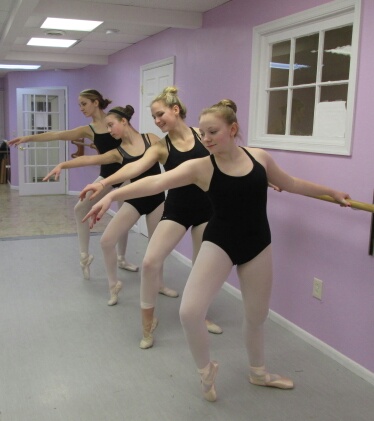Sacrifices of teen dancers along the road of becoming professionals

Dancers are always balancing their school and social lives while also maintaining the dedication they hold in the studio.
January 6, 2015
When it comes to dancing, you don’t develop finesse in one night. In ballet, for example, it takes years to perfect some of the solid basics and techniques. The life of an adolescent dancer consists of many things. Dancers have to manage their time between homework, high school, social life, and sleep. Sacrifices are made in all areas.
I went to a dance school, in the Lansdale area, and spoke to some dancers. The majority of them in the advanced ballet class are currently in their junior year of high school.
A dancer comments, “It’s funny how people say dance isn’t a sport because they have no idea.”
In the advanced class, members can spend between 5 ½-8 or 10- 15 hours a week attending rehearsals and various dance classes. Like most high school students, they must wake up around the hours of 5 and 6AM to go to school the next morning.
A dancer from the advanced class adds, “My sleep is a sacrifice. That just might be because I’m in high school and I’m taking really demanding classes. The four hours that I’m here really takes a chunk out of my day.”
Both ballet classes in the intermediate level and the advanced level agree that if they can’t finish homework before going to dance class they are up late trying to get it finished up.
Lauren Fleming, a dancer in the advanced ballet class, explains, “Sometimes you are working on a group project and you got to go because you have dance. People will be working on it on a Google doc or something. And you’re like ‘Oh I have to go to dance.’ Then, you don’t finish it. People want to work on projects but you can’t.”
Another member from the advanced class, Reilly Power, adds, “Some teachers will just pile homework randomly and if you don’t turn it in you get a zero. And your grade will go down five [percentage] points. My school is really competitive and demanding. You have to just do what you have to do.”
Dancers seem to view and accommodate their social lives differently.
A dancer mentions, “I would take my dance friends as my dance family. It’s not necessarily a social sacrifice for me because I love all of you guys (gestures to class). My friends are here, my priorities are here.”
Reilly Power explains, “I have friends that also dance but not here (the studio). A lot of times we both have dance on Friday nights so sometimes we will hang out on Sundays when we don’t have dance.”
In the advanced ballet class, ¾ people aspire for a career in dance. Unfortunately, in the performing industry, not everybody gets the job they dream for. I asked a professional dance instructor if physical appearance affects the opportunity for an individual to become a ballet dancer in today’s world.
The instructor reflects, “I say that things are changing. When I was a little girl dancers were people size. Average sized people. When I was in my teens which was when Balanchine came into his magnificence he went for many long lean dancers. Very lean very long limbs – very long lean bodies so every dancer had to look like a stick. Now a days it’s starting to move back to normal sized people. Not totally.”
The class had a brief discussion on how they felt about this.
Lauren Fleming shares, “I feel that there’s not a specific way a dancer has to be (physically appearance). Different body types- different shapes and sizes are good for different things. Depending on your body type maybe you could have better extensions or you could have better turns.”
Despite the many sacrifices they make, the passions of teen dancers drive them to do what they love most. This is something that audiences don’t consider behind a young dancer they see onstage.









